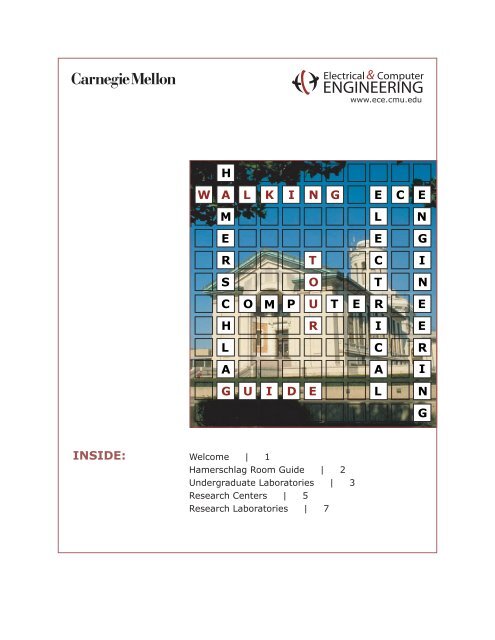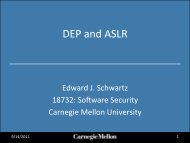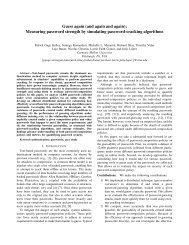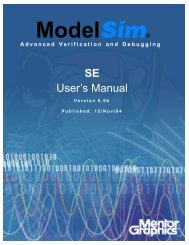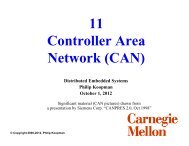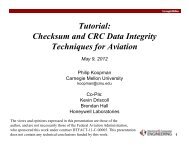Hamerschlag Hall Walking Tour Guide - Electrical and Computer ...
Hamerschlag Hall Walking Tour Guide - Electrical and Computer ...
Hamerschlag Hall Walking Tour Guide - Electrical and Computer ...
Create successful ePaper yourself
Turn your PDF publications into a flip-book with our unique Google optimized e-Paper software.
H<br />
W A L K I N G<br />
M<br />
E<br />
R<br />
S<br />
C<br />
H<br />
L<br />
A<br />
G<br />
T<br />
O<br />
O M P U T E R<br />
R<br />
U I D E<br />
INSIDE: Welcome | 1<br />
<strong>Hamerschlag</strong> Room <strong>Guide</strong> | 2<br />
Undergraduate Laboratories | 3<br />
Research Centers | 5<br />
Research Laboratories | 7<br />
www.ece.cmu.edu<br />
E<br />
L<br />
C<br />
T<br />
I<br />
C<br />
A<br />
L<br />
C<br />
E<br />
N<br />
E G<br />
I<br />
N<br />
E<br />
E<br />
R<br />
I<br />
N<br />
G
W E L C O M E<br />
Dear ECE Visitor:<br />
Welcome to the Department of <strong>Electrical</strong> <strong>and</strong> <strong>Computer</strong> Engineering (ECE) at Carnegie Mellon.<br />
As you find your way through the corridors of our buildings, I would like to call your attention<br />
to some important information:<br />
1. ECE is the largest department within Carnegie Mellon’s engineering college,<br />
the Carnegie Institute of Technology. In fact, ECE is one of the largest<br />
departments on the campus. ECE has over 80 faculty members, including<br />
research, adjunct, <strong>and</strong> courtesy faculty. The department serves about 450<br />
undergraduate <strong>and</strong> approximately 300 graduate students.<br />
2. Exciting new research is taking place in ECE. Cutting edge research areas<br />
include cyber-security, information processing <strong>and</strong> storage, <strong>and</strong> nano-enabled<br />
technologies. Many interdisciplinary research centers <strong>and</strong> laboratories have a<br />
home in the ECE Department; this booklet contains a section identifying them.<br />
3. The ECE Department collaborates with partners from academia <strong>and</strong> industry<br />
both locally <strong>and</strong> worldwide. Although the majority of our work takes place on<br />
the Carnegie Mellon campus, our collaborations extend far beyond Pittsburgh. We<br />
are engaging in global collaborative research <strong>and</strong> teaching efforts through extension<br />
of our academic programs <strong>and</strong> research agreements.<br />
We hope this booklet will provide a useful aid as you become familiar with the department.<br />
The directory of <strong>Hamerschlag</strong> <strong>Hall</strong> will guide you along your way. A section describing ECE<br />
undergraduate laboratories in <strong>Hamerschlag</strong> <strong>Hall</strong> provides a glimpse into the world of our<br />
undergraduates. The final section defining our many centers <strong>and</strong> laboratories will give you an<br />
idea of the range of our commitment to the field.<br />
Happy touring!<br />
T. E. Schlesinger<br />
Professor <strong>and</strong> Head<br />
ECE Department<br />
Carnegie Mellon University<br />
1
H A M E R S C H L A G<br />
R O O M G U I D E<br />
Floor Room Description<br />
4 ------ Graduate Student Lounge; CMU Radio Club<br />
3 ------ Faculty, Staff, <strong>and</strong> Student Offices<br />
2 ------ Faculty, Staff, <strong>and</strong> Student Offices<br />
1 ------ Main Entrance<br />
1107 Undergraduate <strong>Computer</strong> Cluster<br />
1108, 1109 ECE Administrative Offices<br />
1110 Undergraduate Office/Advising<br />
1113 Undergraduate Student Lounge<br />
1115 Graduate Office<br />
1114, 1116 Business Office, Receptionist<br />
1118 Office of Alumni <strong>and</strong> Student Relations<br />
1200 wing Microelectromechanical Systems (MEMS)<br />
1301 Tech Electronics Shop<br />
1303, 1305, 1307 ECE Undergraduate Labs<br />
A ------ ECE Faculty, Staff, <strong>and</strong> Student Offices<br />
A101, 104 ECE Undergraduate Labs<br />
A108 Machine Shop<br />
B ------ ECE Faculty, Staff, <strong>and</strong> Student Offices<br />
B103, 131 Lecture <strong>Hall</strong>s<br />
B300 Mechanical Engineering Wing<br />
C ------ H<strong>and</strong>icapped Entrance<br />
C124 Mechanical Engineering Laboratories<br />
D ------ ECE Faculty, Staff, <strong>and</strong> Student Offices<br />
------ Mechanical Engineering Space<br />
300<br />
Wing<br />
Stairway<br />
100<br />
Wing<br />
200<br />
Wing<br />
Floor Plan for <strong>Hamerschlag</strong> <strong>Hall</strong> floors<br />
1 through 3 <strong>and</strong> A through D. ECE has<br />
additional office <strong>and</strong> laboratory space<br />
in Roberts Engineering <strong>Hall</strong>, Porter <strong>Hall</strong>,<br />
<strong>and</strong> the Collaborative Innovation Center.<br />
2
U N D E R G R A D U A<br />
L<br />
A B O R A T O R I E S<br />
HH 1107 - ECE Undergraduate <strong>Computer</strong> Cluster<br />
Students entering their sophomore year in ECE receive an account allowing access to cluster<br />
machines. Except when reserved for a class, this cluster is available to all ECE undergraduates.<br />
Students can log on to state-of-the-art machines in the cluster at the terminal or remotely.<br />
The computers are used for courses such as “Introduction to <strong>Computer</strong> Architecture,”<br />
“Analysis <strong>and</strong> Design of Digital Circuits,” <strong>and</strong> capstone design courses in analog <strong>and</strong> digital<br />
integrated circuits. Since these machines contain various industry-st<strong>and</strong>ard software packages,<br />
students do not have to purchase the software for some courses. Cluster computers<br />
also provide email, word processing, <strong>and</strong> presentation software for the preparation of lab<br />
reports <strong>and</strong> project presentations.<br />
HH 1303 - Fundamentals of <strong>Computer</strong> Engineering Lab<br />
In this required sophomore level course, 18-240, students work in pairs on four or five labs,<br />
each lasting from one to three weeks. The course introduces basic issues in design <strong>and</strong> verification<br />
of modern digital systems. Topics include Boolean algebra, digital number systems <strong>and</strong><br />
computer arithmetic, combinational logic design <strong>and</strong> simplification, sequential logic design<br />
<strong>and</strong> optimization, register-transfer design of digital systems, basic processor organization<br />
<strong>and</strong> instruction set issues, assembly language programming <strong>and</strong> debugging, <strong>and</strong> a hardware<br />
description language. Students use computer-aided digital design software <strong>and</strong> actual hardware<br />
implementation laboratories to learn about real digital systems. They also write Verilog<br />
descriptions of circuits. Verilog is a hardware description language used to model logic hardware<br />
designs. Each student tests his or her description on a software simulator <strong>and</strong> finally<br />
downloads the description to the Altera field-programmable gate array (FPGA) board, transforming<br />
the device into a working hardware system.<br />
HH 1305 - Fundamentals of <strong>Electrical</strong> Engineering Lab<br />
T E<br />
This required sophomore-level course, 18-220, covers fundamental topics that are common<br />
to a wide variety of electrical engineering devices <strong>and</strong> systems. Topics include circuit analysis<br />
techniques, passive <strong>and</strong> active component modeling, operational amplifiers, energy storage<br />
elements, power analysis, time-response of first <strong>and</strong> second-order systems, sinusoidal steadystate<br />
response, frequency domain analysis, <strong>and</strong> filters. Other topics may include diodes <strong>and</strong><br />
transistors, basic noise analysis, transformers, pole-zero plotting, <strong>and</strong> analysis in the complex<br />
3
plane. The laboratories provide students with opportunities to build <strong>and</strong> operate circuits that<br />
address concepts covered in the lectures, including circuit <strong>and</strong> component modeling, amplifiers,<br />
filters, <strong>and</strong> signal detection <strong>and</strong> processing. Students work in pairs on approximately ten<br />
labs, each lasting one to two weeks. Each computer station contains a signal generator <strong>and</strong><br />
an oscilloscope (used to capture measurements <strong>and</strong> print graphs). Students test their designs<br />
on protoboards; when their designs work according to specifications they build them on<br />
printed circuit boards.<br />
HH 1307 - Embedded Systems <strong>and</strong> Capstone Design Course Lab<br />
During the Fall semester, this room is used as the lab for a junior-level course in embedded<br />
systems. In the Spring, the room is shared by two capstone design courses. In these three<br />
courses students work in groups of three to five. The embedded systems course involves a<br />
series of labs emphasizing core embedded operating system functionality as well as control/<br />
debugging features such as timers, interrupts, serial communications, flash memory, device<br />
drivers <strong>and</strong> other components used in typical embedded applications. In the capstone design<br />
courses, students work on a semester-long project. They present design proposals, create<br />
timetables for accomplishing various milestones, <strong>and</strong> give class presentations detailing group<br />
<strong>and</strong> individual progress. Each group receives a reasonable budget for purchasing additional<br />
hardware components for their project. Students can access the room around the clock via<br />
keycards. Past projects have included face <strong>and</strong> speech recognition systems, music compression,<br />
<strong>and</strong> a wireless intercom system.<br />
HH A101 - Introduction to <strong>Electrical</strong> <strong>and</strong> <strong>Computer</strong> Engineering Lab<br />
Every department in the college offers an introduction to engineering course that provides a<br />
preview of further courses in that department. During the freshman year engineering<br />
students are required to take two introductory courses to help them choose a home department.<br />
The ECE Department’s introductory course, 18-100, provides fundamental skills in<br />
circuit analysis <strong>and</strong> digital design that serve as a foundation to future course work. In the lab,<br />
students are given an opportunity to better underst<strong>and</strong> basic electrical components by<br />
constructing <strong>and</strong> testing an electromechanical system (i.e., a robot). While the robot lab is a<br />
challenging first-year design project, the course provides clear guidance at every step. Each<br />
week students construct a single component based on a circuit specification, then test it <strong>and</strong><br />
consider how it operates when the values are changed.<br />
HH A104 - Signals <strong>and</strong> Systems Lab<br />
“Signals,” as it is commonly abbreviated, represents one of the many breadth courses offered<br />
by the ECE Department. This junior-level course covers a broad area of study that includes<br />
digital communications, digital signal processing, <strong>and</strong> multimedia coding. “Signals” teaches<br />
students how to mathematically model a time-varying signal <strong>and</strong> ask questions about the<br />
effects of various transformations. During lab time, students write short computer programs<br />
that transform small example signals <strong>and</strong> speech waveforms. This activity provides useful<br />
insight into the application of course material to model real-world signals, such as audio<br />
synthesis in MP3 players.<br />
4
R E S E A R C H<br />
C E N T E R S<br />
ECE undergraduates have the opportunity to plan <strong>and</strong> conduct independent engineering<br />
research, development, or design projects, usually in concert with the research interests <strong>and</strong><br />
programs of faculty members. The research centers in ECE identify some of the thrusts of<br />
research carried out by ECE faculty. In addition to participating in projects through these<br />
centers, ECE students take advantage of Carnegie Mellon’s encouragement in interdisciplinary<br />
exploration <strong>and</strong> work with faculty in robotics, computer science, physics, <strong>and</strong> other disciplines<br />
throughout campus.<br />
Carnegie Mellon CyLab<br />
www.cylab.cmu.edu/<br />
With increased reliance on advanced information technology comes the need to make<br />
information systems more secure, trustworthy, sustainable, <strong>and</strong> available, in the face of both<br />
intentional attacks <strong>and</strong> accidental faults. Carnegie Mellon CyLab is a university-wide, multidisciplinary<br />
initiative involving more than 200 faculty, students, <strong>and</strong> staff working closely with<br />
the CERT Coordination Center (CERT/CC), an internationally recognized center of internet<br />
security expertise.<br />
Center for Circuit & Systems Solutions (C2S2)<br />
http://c2s2.ece.cmu.edu/<br />
C2S2 develops long-range design solutions for next-generation circuits, systems built from<br />
circuits, <strong>and</strong> the software that runs on them. C2S2 is a consortium of America’s best research<br />
universities funded jointly by the U.S. semiconductor industry MARCO Focus Center Research<br />
Program <strong>and</strong> the U.S. Department of Defense.<br />
Center for Silicon System Implementation (CSSI)<br />
www.ece.cmu.edu/~cssi/<br />
As system sizes head toward trillions of transistors, implementation of an electronic system<br />
in silicon must consider new forms of design regularity <strong>and</strong> structure simultaneously with<br />
advancement in design automation. CSSI, built from the infrastructure of the Center for<br />
5
Electronic Design Automation established in 1982, has strong ties to national <strong>and</strong> international<br />
semiconductor, design, <strong>and</strong> electronic design automation industrial communities.<br />
Center for Wireless <strong>and</strong> Broadb<strong>and</strong> Networking (CWBN)<br />
www.ece.cmu.edu/~cwbn/<br />
CWBN is an interdisciplinary center for research <strong>and</strong> education in advanced networking<br />
concepts <strong>and</strong> systems with an emphasis on industrial relevance. Founded in 2001, the Center<br />
builds on university strengths in interdisciplinary research, wireless networking, <strong>and</strong> optical<br />
devices <strong>and</strong> signal processing.<br />
Data Storage Systems Center (DSSC)<br />
www.ece.cmu.edu/research/dssc/<br />
DSSC is an interdisciplinary research <strong>and</strong> educational organization whose mission is to<br />
advance information storage technologies with a focus on materials, fabrication, devices, servo<br />
systems, signal processing, <strong>and</strong> coding. The Center works closely with industrial partners to<br />
define projects that will advance beyond the current frontiers of magnetic recording, optical<br />
data storage, probe based systems, holographic processes, <strong>and</strong> solid state memory.<br />
General Motors-Carnegie Mellon Collaborative Research Laboratory (GM/CM-CRL)<br />
http://gm.web.cmu.edu/<br />
The GM/CM-CRL is an interdisciplinary organization formed to foster close collaboration<br />
between General Motors <strong>and</strong> Carnegie Mellon researchers working toward making the automobile<br />
the next information technology platform in our society. The Lab’s work is broadly divided<br />
into the areas of design methodologies, wireless systems, reliable embedded systems, <strong>and</strong><br />
human vehicle interfaces.<br />
Parallel Data Laboratory (PDL)<br />
www.pdl.cmu.edu/<br />
The PDL addresses a broad spectrum of data storage-related challenges including secure<br />
storage, emerging technologies, disk characterization <strong>and</strong> modeling, efficient storage access,<br />
storage networking, <strong>and</strong> network-attached storage clusters. Close ties with industry <strong>and</strong> the<br />
government agencies that have a critical need for these technologies is a hallmark of the PDL.<br />
6
R E S E A R C H<br />
L A B O R A T O R I E S<br />
Advanced Mechatronics Laboratory (AML)<br />
www-2.cs.cmu.edu/~aml/<br />
Research in the AML focuses on the idea of rapidly deployable intelligent systems. The main<br />
threads of this research are composition, collaboration, task management, <strong>and</strong> adaptation.<br />
Past AML projects have been in distributed information systems, distributed robotics systems,<br />
distributed design systems, intelligent instruments, sensor-based robotics, reconfigurable<br />
systems, <strong>and</strong> adaptive software.<br />
<strong>Computer</strong> Architecture Laboratory at Carnegie Mellon (CALCM)<br />
www.ece.cmu.edu/~calcm/<br />
CALCM brings together faculty <strong>and</strong> students from all branches of computer architecture<br />
including parallel architecture, reconfigurable architecture, low power architecture, <strong>and</strong><br />
applications of parallel architecture in biotechnology.<br />
Microelectromechanical Systems (MEMS) Laboratory<br />
www.ece.cmu.edu/~mems/<br />
The MEMS Laboratory is engaged in research on sensor <strong>and</strong> actuator systems that comprise<br />
mechanical features measuring in microns <strong>and</strong> components numbering from few to millions.<br />
Areas of interest include nanometer-scale data storage, microsensors <strong>and</strong> microactuators,<br />
MEMS design tools, micromechanical component modeling, embedded microinstruments,<br />
<strong>and</strong> microrobotics.<br />
ECE IEEE Spring Barbeque<br />
7
CARNEGIE MELLON STATEMENT OF ASSURANCE<br />
www.ece.cmu.edu<br />
Carnegie Mellon University does not discriminate <strong>and</strong> Carnegie Mellon University is required not to<br />
discriminate in admission, employment, or administration of its programs or activities on the basis of<br />
race, color, national origin, sex or h<strong>and</strong>icap in violation of Title VI of the Civil Rights Act of 1964, Title IX<br />
of the Educational Amendments of 1972 <strong>and</strong> Section 504 of the Rehabilitation Act of 1973 or other<br />
federal, state, or local laws or executive orders.<br />
In addition, Carnegie Mellon University does not discriminate in admission, employment or administration<br />
of its programs on the basis of religion, creed, ancestry, belief, age, veteran status, sexual orientation or<br />
in violation of federal, state, or local laws or executive orders. However, in the judgment of the Carnegie<br />
Mellon Human Relations Commission, the Department of Defense policy of, “Don’t ask, don’t tell, don’t<br />
pursue,” excludes openly gay, lesbian <strong>and</strong> bisexual students from receiving ROTC scholarships or serving<br />
in the military. Nevertheless, all ROTC classes at Carnegie Mellon University are available to all<br />
students.<br />
Inquiries concerning application of these statements should be directed to the Provost, Carnegie Mellon<br />
University, 5000 Forbes Avenue, Pittsburgh, PA 15213, telephone (412) 268-6684 or the Vice President<br />
for Enrollment, Carnegie Mellon University, 5000 Forbes Avenue, Pittsburgh, PA 15213, telephone (412)<br />
268-2056.<br />
Obtain general information about Carnegie Mellon University by calling (412) 268-2000.<br />
Carnegie Mellon University publishes an annual campus security report describing the university’s<br />
security, alcohol <strong>and</strong> drug, <strong>and</strong> sexual assault policies <strong>and</strong> containing statistics about the number <strong>and</strong><br />
type of crimes committed on the campus during the preceding three years. You can obtain a copy by<br />
contacting the Carnegie Mellon Police Department at (412) 268-2323. The security report is available<br />
through the World Wide Web at http://www.cmu.edu/security/stats.html.<br />
8


